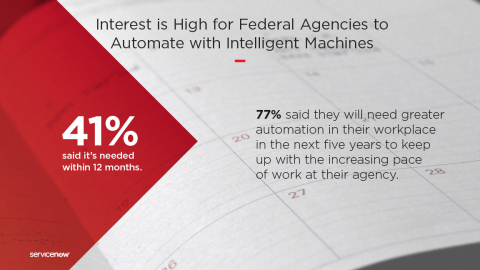SANTA CLARA, Calif.--(BUSINESS WIRE)--ServiceNow (NYSE: NOW) today released the results of a new survey, “Today’s State of Federal Automation,” that for the first time reveal that 41% of federal decision-makers indicate they need intelligent machines to keep up with the rising volume of everyday work, but the adoption of machine learning in the federal sector is stymied by the use of existing legacy tools. These technology advances promise greater accuracy, cost reduction and more time to focus on value-added work.
ServiceNow commissioned Market Connections to poll 150 decision-makers from federal civilian, defense and intelligence agencies to evaluate their views and adoption of intelligent automation comprising artificial intelligence or machine learning software for everyday work. The findings include:
Fed agencies waste time on routine manual tasks and need greater automation to get work done
- 77% said they will need greater automation in their workplace in the next five years to keep up with the increasing pace of work at their agency. 41% said it is needed within 12 months.
- 77% spend more than a quarter of their workday on manual administrative tasks.
- The top three manual tasks performed at work are emailing updates, requests or approvals (87%), and updating spreadsheets (78%) and electronic documents and forms (77%).
- Interestingly, a third of the respondents still hand deliver paper files to others.
“Fed agencies are approaching the breaking point,” said Bob Osborn, CTO, Federal, ServiceNow. “In an era of smart phones and online conveniences, many in our federal agencies are still delivering the equivalent of interoffice envelopes. Manual work saps productivity and limits federal agencies’ ability to think about and act on their organizational missions.”
For ServiceNow’s recommendations on how to make everyday work more efficient, read this blog post.
Interest is high for federal agencies to automate with intelligent machines
- Most respondents (65%) indicated that their agency is currently using or considering an intelligent automation solution, but a quarter (24%) are not sure of the timeframe.
- Fewer than 1 in 5 (18%) are currently using advanced automation.
- Laggards outnumber the early adopters: 35% say they are not considering it or do not know.
“While it is early days for federal agencies to invest in machine learning, the need is there to remove obstacles to productivity,” said Osborn. “Federal audiences have interest in exploring this area and identifying how they best can apply it to their operations.”
Areas that can benefit most from intelligent automation to everyday work
- The survey identified IT service management as the most automated agency process (58%) today. 42% of respondents indicate HR services are at least somewhat automated in their agency. The least automated service was resolving customer issues (28%).
- More than half indicated that intelligent automation would be very beneficial for the creation of real-time performance reports and analytics—the top area. 43% identified IT service desks and 39% identified resolving security threats.
- 6 in 10 agreed on the top four benefits of automation: accuracy, cost reduction, less time spent on tasks, and freeing up staff to focus resources on value-added tasks.
“While much of the federal world is highly manual, there are bright spots in IT services,” Osborn said. “Greater automation can drive more accurate and speedy work.”
Replacing existing legacy tools is the #1 barrier to the adoption of intelligent automation
- The top concern in adopting more advanced automation was being forced to replace existing legacy technology that they had been heavily invested in. 42% cited that would significantly impact their agency’s planning efforts to integrate and achieve intelligent automation.
- Cost and staffing also posed concerns: 39% said the uncertainty around funds/budget is a significant concern, and 36% said their current staff don’t have the proper training to support these new technologies once implemented.
- Potential job eliminations and layoffs landed at the bottom of the list of concerns (21%).
“Although government leaders and key IT policy makers have emphasized the benefits of adopting modern technology, many agencies are still clinging on to their legacy tools and don’t fully understand the advantages of using advanced automation,” said Osborn. “Federal agencies need to look at how the private sector is using advanced automation today and how they are able to cope with the rising volume of work.”
Respondents agree that not modernizing manual processes will have a negative impact on work
- 66% of respondents said human error will increase.
- 57% said maintaining legacy systems will be costly.
- 55% said reduced productivity will continue.
Tweet: New #ServiceNow survey shows that 41% of federal agencies need to automate work with intelligent machines in next year http://bit.ly/2i1lsaq #GovIT
Survey Methodology
ServiceNow commissioned Market Connections to design and conduct a study to identify the extent in which business processes are handled manually or are automated in federal civilian and defense agencies. The 8-minute online survey was fielded between September 11 and September 22, 2017, in the U.S. A total of 150 respondents who currently work for the federal government and involved in their organization’s decisions or recommendation regarding technology and processes that support administrative functions, completed the survey. The margin of error is ±8% at a 95% confidence level.
About ServiceNow
ServiceNow makes work better across the enterprise. Getting simple stuff done at work can be easy, and getting complex multi-step tasks completed can be painless. Our applications automate, predict, digitize and optimize business processes and tasks, from IT to Customer Service to Security Operation and to Human Resources, creating a better experience for your employees, users and customers while transforming your enterprise. ServiceNow (NYSE:NOW) is how work gets done. For more information, visit: www.servicenow.com.
©2017 ServiceNow, Inc. All rights reserved. ServiceNow, the ServiceNow logo, Now, and other ServiceNow marks are trademarks and/or registered trademarks of ServiceNow, Inc., in the United States and/or other countries. Other company and product names may be trademarks of the respective companies with which they are associated.




